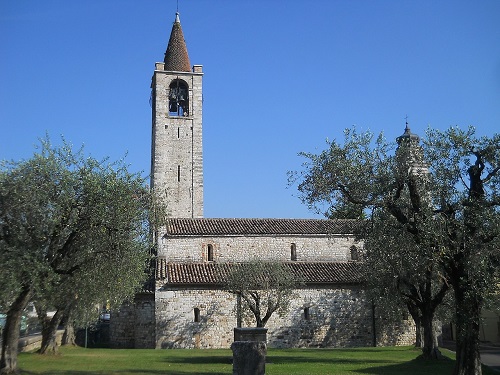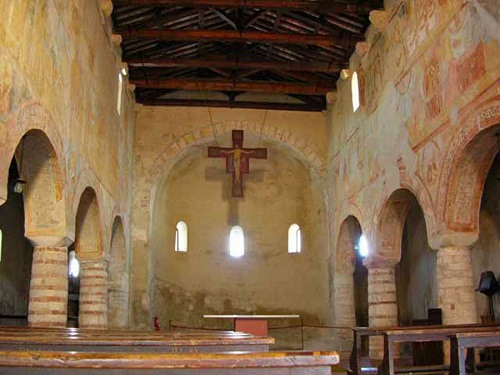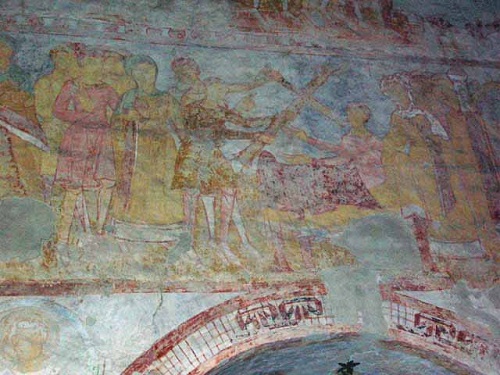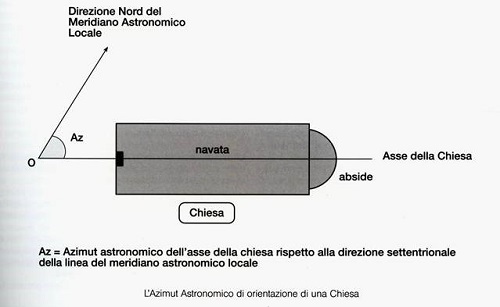
Chiesa di San Severo
Il primo cenno documentato della Chiesa di San Severo risale ad un diploma del 983 di Berengario I, primo Re d’Italia e Imperatore dei Romani, mentre la prima costruzione dell’edificio giunto a noi risale al 1109, come risulta da un’iscrizione scolpita su un capitello della navata principale benché tracce presenti nella parte esterna della cripta suggeriscono che la stessa risalga ad un preesistente ambiente longobardo dell’VIII – IX secolo.

La chiesa venne rifatta ed ampliata agli inizi del XII secolo, probabilmente a seguito del devastante terremoto che nel 1117 ebbe epicentro nella “Bassa Veronese” e si stima provocò almeno 30.000 vittime, distruggendo o danneggiando gravemente abitazioni, chiese, monasteri e monumenti in tutta la provincia, tanto che eliminò le testimonianze architettoniche alto-medievali, ma creò pure l’occasione per la diffusione dello stile romanico; si tratta dello stesso terremoto che a Verona fece crollare la cinta più esterna dell’Arena, donandole però l’attuale configurazione con la caratteristica “ala”.
Divenuta chiesa parrocchiale, San Severo decadde successivamente e per un lungo periodo fino alla metà del XVIII secolo, quando vi si insediarono i confratelli del Santissimo Sacramento che salvarono l’edificio dalla completa rovina, apportandovi però una serie di manomissioni e quando poi nel XIX secolo si trasferirono nella vicina Chiesa della Disciplina, San Severo conobbe un nuovo periodo di degrado poiché venne adibita in successione ad uso magazzino, teatro ed infine deposito militare finché la Regia Soprintendenza, tra il 1927 e il 1943, diede inizio ad una serie di interventi che la restituirono al culto.
Oggi proprietà del Comune di Bardolino, la chiesa ha pianta romanica con tre navate separate da file di cinque archi per lato, con colonne cilindriche formate da strati alterni di biancone e cotto sormontate da capitelli scantonati in pietra, alcuni decorati con semplici motivi in bassorilievo addirittura di origine celtica, come il “Sole delle Alpi” e ciascuna navata termina con un’abside; la copertura è eseguita con capriate lignee e travature a vista.


L’interno è decorato con affreschi di scuola veronese, ma pare di “ispirazione” salisburghese e vengono comunemente datati tra l’XI e la seconda metà del XII secolo, mentre altri secondari risalgono al XIV e al XVIII secolo; i primi si ispirano alla Natività, all’Apocalisse di San Giovanni e alla leggenda del ritrovamento della Santa Croce da parte di Sant’Elena, madre dell’Imperatore Costantino, mentre gli altri sono un gruppo di sei Santi nella navata sinistra e il “Cristo crocifisso fra i confratelli del SS. Sacramento” sotto il piccolo rosone che da luce alla navata centrale.

Una curiosità che io stesso non conoscevo, ma ho imparato scrivendo questo listing, è quella che riguarda l’orientamento astronomico delle chiese romaniche: sin dagli albori del cristianesimo era diffusa la tradizione di orientare i templi, o più in generale i luoghi di culto, verso la direzione Est secondo il criterio denominato “Versus Solem Orientem” in quanto, analogamente ai pagani, anche per i cristiani la salvezza e la rinascita erano collegate alla generica direzione cardinale orientale; Gesù Cristo aveva come simbolo il Sole e la direzione Est era simboleggiata dalla croce, a sua volta emblema di vittoria.
La simbologia solare così direttamente collegata al Cristo richiedeva pertanto un’attenta progettazione dei luoghi di culto, tanto che già nelle Costituzioni Apostoliche del IV e V secolo veniva raccomandato ai fedeli di pregare rivolti verso Est, così pure lo stesso celebrante; come conseguenza di tali prescrizioni, tecnicamente si rese necessario progettare e costruire le chiese orientate con la porta d’ingresso rivolta ad Ovest e l’abside ad Est.

La chiesa è aperta alle visite e al culto ed occasionalmente vi si celebrano matrimoni e qualche cerimonia religiosa.
Una lapide commemorativa posta all’esterno ricorda che nella Primavera del 1848 due bardolinesi, Sante Dal Prete e Giovanni Marchi, furono fucilati dalle truppe austriache con l’accusa di aver sobillato il popolo alla rivolta col suono delle campane.
La cache
ATTENZIONE
La cache si trova all'esterno della chiesa e la ricerca va svolta entro un raggio di 5 metri dal perimetro della stessa.
Non pubblicare immagini spoiler del camuffamento!
Log privi di riscontro sul logbook saranno cancellati senza alcun ulteriore avviso!
Durante la stagione turistica e nei fine settimana GZ è zona ad intenso passaggio di babbani; si raccomanda cautela.
Buona caccia!

Church of St. Severo
The first documented mention of the Church of St. Severo dates back to a diploma of 983 by Berengario I, first King of Italy and Emperor of the Romans, while the first construction of the building that came to us dates back to 1109, as shown by a carved inscription on a capital of the main aisle although traces present in the external part of the crypt suggest that the same goes back to a pre-existing Longobard environment of the VIII - IX century.
The church was rebuilt and enlarged at the beginning of the 12th century, probably following the devastating earthquake that in 1117 had its epicenter in the "Lower Veronese" and is estimated to have caused at least 30,000 victims, severely destroying or damaging dwellings, churches, monasteries and monuments throughout the province, so much so that it eliminated the high-medieval architectural testimonies, but also created the occasion for the spread of the Romanesque style; it is the same earthquake that caused the outer wall of the Arena to collapse, giving it the current configuration with the characteristic "wing".
Having become a parish church, St. Severo subsequently declined and for a long period until the middle of the 18th century, when the confreres of the Blessed Sacrament settled there and saved the building from complete ruin, but with a series of tampering and when in the 19th century moved to the nearby Church of Discipline, St. Severo experienced a new period of degradation as it was used in succession as a warehouse, theater and finally a military deposit until the Royal Superintendency, between 1927 and 1943, began a series of interventions that they returned it to worship.
Now owned by the Municipality of Bardolino, the church has a Romanesque plan with three naves separated by rows of five arches on each side, with cylindrical columns formed by alternating layers of biancone and cotto surmounted by stone capitals, some decorated with simple bas-relief decorative motifs even of Celtic origin, like the “Sun of the Alps” and each nave ends in an apse; the roof is made with wooden trusses and exposed beams.
The interior is decorated with frescoes from the Veronese school, but it seems to be from Salzburg "inspiration" and are commonly dated between the 11th and the second half of the 12th century, while other secondary ones date back to the 14th and 18th centuries; the first are inspired by the Nativity, the Apocalypse of Saint John and the legend of the discovery of the Holy Cross by Saint Helena, mother of the Emperor Constantine, while the others are a group of six Saints in the left aisle and the "Christ crucified among the confreres of the Blessed Sacrament” under the small rose window that gives light to the central nave.
A curiosity that I myself did not know, but I learned by writing this listing, is that which concerns the astronomical orientation of Romanesque churches: since the dawn of Christianity the tradition of orienting the temples, or more generally the places of worship, was widespread towards the East direction according to the criterion called "Versus Solem Orientem" since, similarly to the pagans, even for Christians salvation and rebirth were connected to the generic eastern cardinal direction; Jesus Christ had the Sun as a symbol and the East direction was symbolized by the cross, which in turn was the emblem of victory.
The solar symbolism thus directly connected to Christ therefore required careful planning of places of worship, so much so that already in the Apostolic Constitutions of the 4th and 5th centuries it was recommended to the faithful to pray facing East, as well as the celebrant himself; as a consequence of these prescriptions, technically it was necessary to design and build the churches oriented with the entrance door facing West and the apse to the East.
The church is open to visits and worship and occasionally weddings and some other religious ceremonies are held here.
A commemorative plaque on the outside recalls that in the Spring of 1848 two Bardolinesi, Sante Dal Prete and Giovanni Marchi, were shot by Austrian troops on the charge of having incited the people to revolt with the sound of bells.
The cache
WARNINGS
The cache is located outside the church and the search must be carried out within a radius of 5 meters from its perimeter.
Do not post spoiler images of the camouflage!
Logs without evidence on the logbook will be deleted without any further notice!
During the tourist season and on weekends GZ is an area with intense passage of Muggles; caution is recommended.
Happy hunting!
